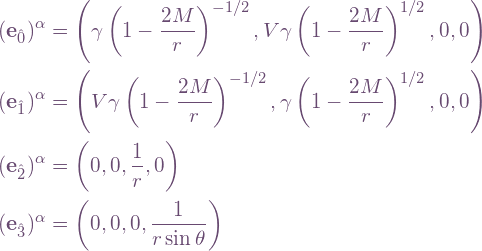I presented this poster, “Static vs Falling: Time slicings of Schwarzschild black holes” at the GR21 conference in New York City, July 2016. You can download a PDF version. A big thank-you to those who gave feedback, especially to Jiří Podolský who encouraged me to publish it! The section on coordinate vectors has been updated. Also there is a major update to the poster.
Category: Spacetime geometries
Tetrad for Schwarzschild metric, in terms of e
The following is a natural choice of orthonormal tetrad for an observer moving radially in Schwarzschild spacetime with “energy per unit rest mass” e:

The components are given in Schwarzschild coordinates. (The ± signs are not independent — they must be either both +1 or both -1. Note that e does not distinguish between inward and outward motion. There is additional freedom to define any of these vectors as their negative.)
We normally think of e as invariant, where there is a presumption of freely falling / geodesic motion, but even if not we can regard it as an instantaneous value.
![]() is the 4-velocity computed previously. The other vectors can be obtained from substituting
is the 4-velocity computed previously. The other vectors can be obtained from substituting ![]() and
and ![]() into the tetrad here.
into the tetrad here. ![]() is determined from
is determined from ![]() and the equation for e above, then V follows from inverting
and the equation for e above, then V follows from inverting ![]() . This orthonormal frame is useful for determining the object’s perspective, e.g. tidal forces, visual appearances, etc.
. This orthonormal frame is useful for determining the object’s perspective, e.g. tidal forces, visual appearances, etc.
Tetrad for Schwarzschild metric
Suppose an observer u moves radially with speed (3-velocity) ![]() relative to “stationary” Schwarzschild observers, where we define
relative to “stationary” Schwarzschild observers, where we define ![]() as inward motion. Then one natural choice of orthonormal tetrad is:
as inward motion. Then one natural choice of orthonormal tetrad is:

where the components are given in Schwarzschild coordinates. This may be derived as follows.
The Schwarzschild observer has 4-velocity
![Rendered by QuickLaTeX.com \[\fvec u_{\rm obs}=\left(\Schw^{-1/2},0,0,0\right)\]](http://cmaclaurin.com/cosmos/wp-content/ql-cache/quicklatex.com-492ec50d4e2d8170e1f27d344d1d02ba_l3.png)
because the spatial coordinates are fixed, and the t-component follows from normalisation ![]() (Hartle
(Hartle  §9.2).
§9.2).
Now the Lorentz factor for the relative speed satisfies ![]() , and together with normalisation
, and together with normalisation ![]() and the assumption that the θ and φ components are zero, this yields
and the assumption that the θ and φ components are zero, this yields ![]() given above.
given above.
We obtain ![]() by orthonormality:
by orthonormality: ![]() and
and ![]() , and again making the assumption the θ and φ components are zero. Note the negative of the r-component is probably an equally natural choice. Then
, and again making the assumption the θ and φ components are zero. Note the negative of the r-component is probably an equally natural choice. Then ![]() and
and ![]() follow from simply normalising the coordinate vectors.
follow from simply normalising the coordinate vectors.
Strictly speaking this setup only applies for ![]() , because stationary timelike observers cannot exist inside a black hole event horizon! Yet remarkably the formulae can work out anyway (MTW
, because stationary timelike observers cannot exist inside a black hole event horizon! Yet remarkably the formulae can work out anyway (MTW  …) . An alternate approach is local Lorentz boost described shortly.
…) . An alternate approach is local Lorentz boost described shortly.
Hartle  … Also check no “twisting” etc…
… Also check no “twisting” etc…
Radial motion in the Schwarzschild metric, in terms of e
A nice way to parametrise the 4-velocity u of a small test body moving radially within Schwarzschild spacetime is by the “energy per unit rest mass” e:
![Rendered by QuickLaTeX.com \[{u^\mu=\left(e\Schw^{-1},\pm\eroot,0,0\right)\]](http://cmaclaurin.com/cosmos/wp-content/ql-cache/quicklatex.com-18f14260dbcfd3c0686a273a72319a5c_l3.png)
For the “±” term, choose the sign based on whether the motion is inwards or outwards. All components are given in Schwarzschild coordinates ![]() . The result was derived as follows. In geometric units, the metric is:
. The result was derived as follows. In geometric units, the metric is:
![Rendered by QuickLaTeX.com \[\Schwmetric\]](http://cmaclaurin.com/cosmos/wp-content/ql-cache/quicklatex.com-c9af12fa8aa92d2f1d3a9a32b73b81fc_l3.png)
By definition ![]() , where
, where ![]() is the Killing vector corresponding to the independence of the metric from t, and has components
is the Killing vector corresponding to the independence of the metric from t, and has components ![]() (Hartle
(Hartle  §9.3). For geodesic (freefalling) motion e is invariant, however even for accelerated motion e is well-defined instantaneously and makes a useful parametrisation.
§9.3). For geodesic (freefalling) motion e is invariant, however even for accelerated motion e is well-defined instantaneously and makes a useful parametrisation.
We want to find ![]() say. Rearranging the defining equation for e gives
say. Rearranging the defining equation for e gives ![]() . Radial motion means
. Radial motion means ![]() , so the normalised condition
, so the normalised condition ![]() yields the remaining component
yields the remaining component ![]() . The resulting formula is valid for all
. The resulting formula is valid for all ![]() , and for e=1 the 4-velocity describes “raindrops” as expected.
, and for e=1 the 4-velocity describes “raindrops” as expected.